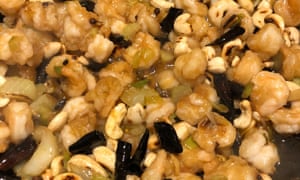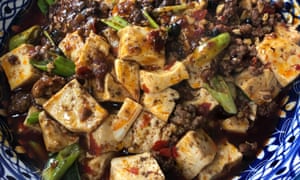The vivid flavours of Sichuan, with Fuchsia Dunlop as our guide
A Saturday morning and I’m roaming the broad aisles of Wing Yip, the thrilling Asian grocery store in Croydon, attempting to deliver color to a life of monochrome. Occasionally, I look from my telephone’s display to the parade of jars, like a misplaced youngster in search of a mum or dad within the crowd. There are a number of of us like this right here right this moment; the baffled, hopeful and pathologically hungry, with ingredient lists for dishes so very removed from our consolation zones.
Happily, I’ve a guide. Her identify is Fuchsia Dunlop. The picture on my telephone is {a photograph} from her guide, The Food of Sichuan. It’s a set of Chinese characters for candy flour sauce, a paste near, however subtly totally different from, hoi sin. Unhelpfully, it has a bunch of totally different names in English. Photographing the Chinese characters is Dunlop’s suggestion and reward be, it really works. I shortly discover an ingredient for twice-cooked pork, one of my favorite Sichuan dishes.
While it may be potential to approximate the dish with out that specific sauce, I couldn’t do it with out Dunlop’s guide; it truly is the important thing ingredient. The Food of Sichuan is an in depth, typically nerdy, typically romantic guide-cum-travelogue by means of what many think about probably the most intricate and vivid of all of the regional Chinese cooking traditions. This 12 months sees the twentieth anniversary of its first publication, an occasion marked by an expanded new version, full with endorsements from the likes of Ken Hom and, er, me. I describe it as “my bible for the subject”, and never unfairly; it’s way more nourishing than any spiritual tract may ever be. It is that almost all stunning of issues: a window by means of which to glimpse, and infrequently take part in, one other type of life.
Dunlop grew up in Oxford. Her mom taught English as a overseas language, and sometimes invited her college students spherical to cook dinner their meals from house. Early on Dunlop started noting down recipes, a behavior which stayed with her when, within the 90s, she went to town of Chengdu in Sichuan province to review on the metropolis’s college and study the language. “During a trip to a nearby fishing village I was scribbling down recipes for what we had just eaten,” Dunlop says now. “My Danish friend Marianne said I should write a book.” Later, she spent three months learning on the Sichuan cookery college, the primary non-Chinese particular person to take action. “I was very rigorous in taking notes.”
Dunlop may see a spot available in the market. “There weren’t any Chinese cookbooks [in the west] that had been researched on the ground, in the way they had for the Middle East or Italy,” she says. Publishers had been much less satisfied; her first proposal was turned down by all of them for being “too narrow”. A 12 months later she tried once more. This time she was profitable. The world was launched to the shocking delicacy of dishes intertwining purple chillies with numbing Sichuan peppercorns; to the choreographed dance of salt and candy and bitter; to the thrill of fuhewei, the compound flavours that give these dishes their showy, high-kicking attraction.
Like all one of the best cookbooks, it locations the dishes in context. “It’s one of those books that has to be started at the back,” says the chef Jeremy Pang, who runs the School of Wok in central London. He’s not flawed: that’s the place you’ll discover lists of seasonings and shares, and an account of the “23 flavours of Sichuan”: the numbing and sizzling, the scorched chilli, the fragrant-boozy and extra. Meanwhile, on the entrance there are pages on the 56 cooking strategies and the numerous totally different knife cuts. “Chinese cooking is so complex,” Pang says, “and this book shines a light on that.” He additionally loves the best way it strikes an understanding of Sichuan meals far past the plain headline attraction of chillies and peppercorns. “As Fuchsia says, texture is vital.” He professes a love for the white pork in garlicky sauce and the steamed aubergine with scorched inexperienced peppers, to be eaten sizzling or chilly.
Chef Andrew Wong, of the much-admired London restaurant A Wong, can also be an enormous fan. “The recipes are accurate in a way lots of Chinese cookbooks really aren’t,” he says. (Impressively, an version in Chinese has simply been revealed in China.) Are there any recipes he turns to repeatedly? “There was a point when I was always making her fish-fragrant aubergine.” The key factor, Wong says, is Dunlop’s foresight. “She was ahead of her time in recognising that the food would catch on.” Dunlop is partly liable for that, too. She was a marketing consultant to London’s Barshu, the primary particularly Sichuan restaurant within the UK, which opened in 2006. Now Sichuan eating places are in all places. “I’m surprised by the speed with which it spread,” she says. “Then again I did know how appealing the food would be.”

I resolve to have a go at that twice-cooked pork, the gong bao prawns and mapo tofu, all dishes I do know properly from my consuming adventures in eating places. It provides me one thing to benchmark my efforts towards. Dunlop’s instructions are clear. Nevertheless, cooking this meals is difficult. Quickly my kitchen degenerates into barely managed chaos. Surfaces fill with bowls: of chopped spring onions right here and fermented black beans there; of purple chillies blended in with peppercorns; of sauces mixing Shaoxing wine and Chinkiang vinegar. Eventually I abandon the concept of doing three dishes. The mapo tofu is delay for one more day.
I simmer the slab of pork stomach with aromatics, let it cool then slice it as much as be wok fried. This recipe, like many of them in The Food of Sichuan, makes use of the language of the subjective. The meat should be fried till it smells “delicious”; livid-red Sichuan chilli paste should be cooked out in oil till it smells “wonderful”. Dunlop is constant on this. The recipe for mapo tofu, that basic dish of cubed, wobbly bean curd in a cheek-slapping sauce, additionally requires the chilli paste be cooked till “wonderful”. I do as I’m advised. Wonderful is what I crave. Wonderful is what I would like.

To my disgrace, I scorch the chillies in an excessively sizzling wok for the gong bao prawns and curse myself. Nevertheless, I end with meals I recognise; it’s the first time I’ve cooked dishes at house resembling these I’ve eaten in Chinese eating places. There’s that twice-cooked pork, with shoots of sensible inexperienced and a rust-coloured sauce of fermented beans; there are fats prawns like punctuation marks with cashews and the waft of Shaoxing wine; and, a day or two later, that almost all comforting of fearsome-looking dishes, the mapo tofu. The washing up could also be copious. The work surfaces could also be splattered. But this stomach says, “Thank you Fuchsia. You took me somewhere else.”
The Food of Sichuan by Fuchsia Dunlop (Bloomsbury, £30). Buy a replica for £26.10 from guardianbookshop.com
News bites
London’s Riding House Café has launched Soul Ride, a supply providing accessible to a lot of the UK, which attracts upon chef-patron Henry Omereye’s love for and data of Caribbean meals. The brunch field for £55 features a smoked pepper stew with coconut and avocado, buttermilk pancake combine and a sorrel and hibiscus prosecco, whereas the stonking £120 Soul Ride Weekender Box accommodates salt cod fritters, curry mutton, jerk rooster burgers and a sticky date and spiced rum pudding, amongst many different issues (ridinghouseathome.com).
Leiths School of Food and Wine has created an expanded set of on-line cookery programs throughout lockdown. Alongside the complete 24-week skilled, accredited ‘essential cooking certificate’ they’re additionally now operating shorter programs, together with one aimed toward 13-to-18-year-olds and one other on the necessities of ‘plant-based’ meals. The latter runs for six weeks and prices £295 (leiths.com).
The workforce behind Manchester’s Escape to Freight Island website has, with enviable optimism, introduced a foods and drinks pageant from 28 to 31 May. The Kantina Weekender will characteristic cooks together with Mary-Ellen McTague from Chorlton’s Creameries, Gary Usher from Elite Bistros, Stosie Madi from Parker’s Arms and Sam Buckley from Stockport’s Where The Light Gets In. They will all be teaming up with foods and drinks operators who’re already half of the foods and drinks market. Tickets value £35, charged again towards your foods and drinks spend. To guide, go to kantinaweekender.com.
Email Jay at [email protected] or observe him on Twitter @jayrayner1




